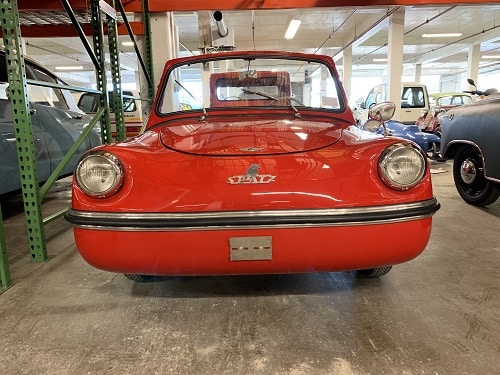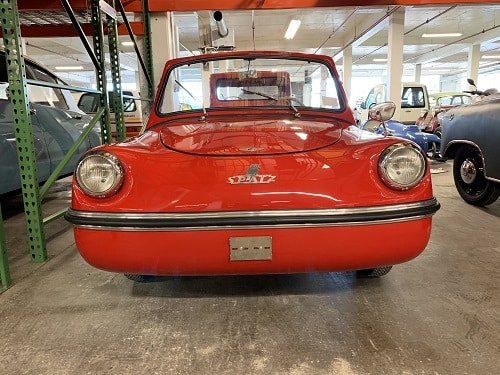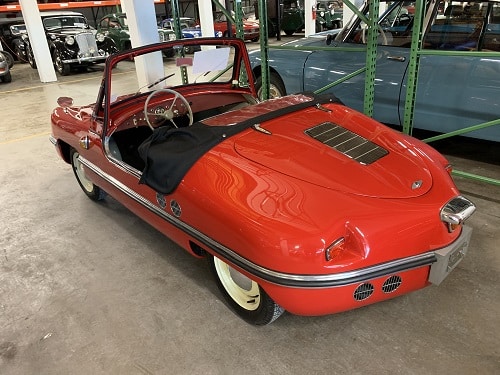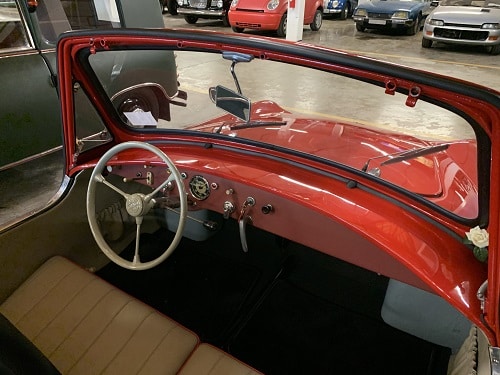
BAG Spatz- 1957

The original design of the Spatz was penned by German automaker Egon Brütsch. He was one of the world’s most prolific microcar engineers and designed eleven different car models between 1952 and 1958, such as the Mopetta—but he hardly sold any. He relied mostly on selling licenses to produce his designs. He built the Brütsch 200 Spatz (German for Sparrow), a diminutive, smooth space saucer-like open three-wheeler he’d presented at the Paris Salon in 1954. It was attractive and stylish, made mostly of fiberglass without a chassis. This was in the early days of fiberglass and its strengths were often over-estimated! Inevitably, the Spatz cracked in many places.
Harald Friedrich, co-owner of the German machine tool company, Alzmetall, purchased the license to produce the Brütsch 200 Spatz in 1954. However, the car proved to be unroadworthy. Friedrich hired Tatra engineer Dr. Hans Ledwinka to redesign the car. In Ledwinka’s hands, the new model was restructured with a much needed central backbone tube and a more stable four-wheel layout, instead of the original three. The front wheels hung on a separate subframe and the rear wheels were on swing axles. Strut suspension and hydraulic brakes were also added. The 191cc single cylinder Fichtel & Sachs engine was retained, but relocated in front of the rear wheels, which gave it great balance. The new model possessed a similar look, except the Plexiglas windshield had been replaced with split glass. By then, the original car had been altered so much Friedrich believed they were free from paying any licensing fees, though Brütsch would later take them to court. Friedrich prevailed.
The first examples left the production line in June, 1955 simply as Spatz. It’s diminutive, slippery fiberglass bodyshell quickly earned the moniker “one-eighth Corvette.” However, the celebration quickly subsided when an engine caught fire during an important magazine review. Quickly moving on, the next version of the Spatz was designed as a prototype with an inventive “gullwing” hardtop, but an earlier patent under Hans Trippel (famous for the Mercedes-Benz Gullwing) prevented the model from ever being produced. Friedrich then searched for a production partner, which he found in the motorcycle manufacturer Victoria and together they formed Bayerische Autowerke GmbH (BAG) in 1956.
Though improvements soon followed, such as a 250cc model, Victoria 250, it was clearly understood by October of the same year that the market would not support yet another microcar. The last examples carried the name Burgfalke 250, after the aircraft company it became involved with in 1957, but few of them were ever made. Burgfalke would eventually become merely a parts supplier for the existing cars. Manufacturing ended in February 1957.
Specifications:
Manufacturer: Bayerische Autowerke GmbH (BAG)
Country of Origin: Germany
Drivetrain Configuration: Rear engine, rear-wheel drive
Engine: Air-cooled, single-cylinder, two-stroke, 191cc Fichtel & Sachs, 10hp
Transmission: Sequential, positive-stop four-speed with four-speed reverse
Top Speed: 50 mph
Years of Production: 1956 -1957
Number Produced: 859 Spatz 200
Original Cost: $365.00


